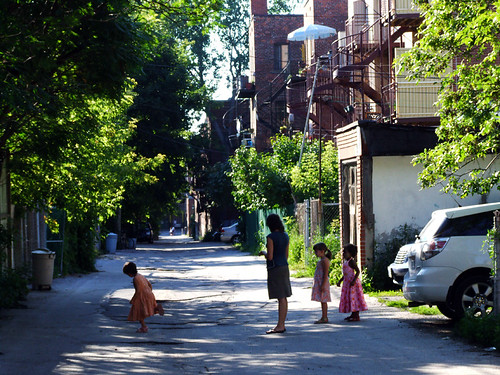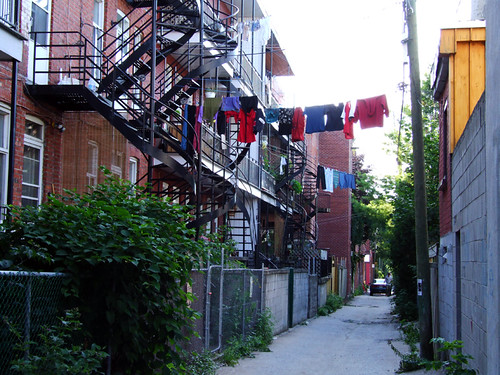In many ways, Montreal is a remarkably heterogeneous city, and its built form is no exception. Each individual neighbourhood is distinct enough to provide the aimless walker with enough visual cues to figure out where he or she is.
Alleys, too, vary from one part of the city to the next. In nineteenth-century neighbourhoods, they’re often aimless, terminating in dead ends and unexpected courtyards. Twentieth-century lanes are more standard in their arrangement, but even then, there is a great deal of difference between them. Many of the alleys in the old town of Delorimier, on the Plateau, are surprisingly overrun with vegetation, giving them an almost rural feel; not too far away, the lush streets of Outremont are counterbalanced by narrow, denuded lanes lined by tall brick buildings.
Mile End falls somewhere in between. Compared to many neighbourhoods, its alleys are remarkably narrow, and they tend to be lined by garages and the back ends of buildings, or at least some pretty imposing walls and fences. But there’s no shortage of greenery, either, and all of this has the effect of making the lanes feel remarkably cozy and hemmed-in. Even more interesting is the clutter you find in them: discarded furniture, oddly-painted fences, street art, run-down sheds and garages — sometimes even entire houses that are hidden from the street. It’s fun to walk down the alleys and peek into the backyards and rear balconies, comparing the gardening habits of neighbours or juxtaposing messy, debris-and-laundry-filled backyards (long-time Mile End residents) with others that are immaculately-arranged and well-stocked with expensive patio furniture (finnicky suburban transplants).
Depending on your route, it’s possible to walk from one side of Mile End to the other making use only of laneways, and I often like to cut through the alleys when I’m going somewhere. There are far too many of them to suggest a good walking route — the best thing to do is to pick one and just wander aimlessly, doing as much as possible to avoid the actual streets. (It’s always great when two alleys intersect, which gives you the impression of being caught in some sort of alternate street grid, a secret double-city that is quieter and more mysterious.)
Still, there are some laneways in particular that are worth checking out, for various reasons. In the alley running between Jeanne-Mance and Esplanade, from Villeneuve to St. Joseph, you can see an the old boiler room, capped by a tall chimney, that provided heat and water to a block of triplexes on Villeneuve, the first (and, as far as I can tell, only) such plexes built with central heating. Groll Avenue, a bit to the north, is an alley in all but name. Built for no apparent reason when Mile End first developed (it breaks up the extremely long block between Fairmount and St. Viateur, but only runs from Park to St. Urbain), it was pedestrianized in the 1990s, and it’s a nice way to cut across the heart of the neighbourhood.
There are even some unexpected businesses in the lanes. The alley just above Fairmount, between St. Urbain and Clark, is home to a discreetly-located bike co-op. Between Bernard and Van Horne, in the alley between St. Urbain and Waverly, is Backroom Records and Pastries, a music and bake shop that was closed last year but has reportedly reopened. In the alley just past the St. Viateur bagel shop, meanwhile, a large bazaar takes place nearly every Sunday.
Here’s a map of all the locations mentioned in this article. Have fun exploring.




6 comments
Interesting article but i completely disagree with your stereotyping of long-time residents vs suburban transplants. I find the situation is completely reverse. New ‘suburban’ transplants, which are more just post-teenaged brats living off their parents income, tend to have the messy backyards, whereas the nicely manicured gardens tend to belong to long-time residents (the European immigrants who have been there the longest).
What I had in mind when I wrote that weren’t the students or twenty-somethings, it was the families who buy entire duplexes and convert them into single-family homes.
Many of the long-time immigrant residents of Mile End have very functional backyards: there’s a vegetable patch, a clothesline, a pile of bricks and wood from some ongoing repairs, some old junk that needs to be sorted, etc. Now contrast that with the yards behind some highly renovated plexes, the kind with new floor-to-ceiling windows and the back and a gutted open-space interior. They often have backyards that seem more for show than anything else.
Of course, these are nothing more than vast generalizations, and there are many different people in Mile End, each one with a different approach to maintaining his or her back yard.
Love the alleys of Mile End! I’ve been skulking up and down them since it got warm, finding bits and pieces of fun stuff to use in my garden. I am very impressed by the Italian and Portugues gardeners who really work their little plots like a small farm. How much tomato sauce do they make each year?! It’s astounding. I could learn a thing or two from them, I’m sure.
Yes, backyards are especially hard to generalize about.
I believe that Groll had something to do with access for horses to a watering trough at St. Urbain.
Thanks to your map of interesting spots I had a nice afternoon today wandering down (N -> S) these alleys/ruelles, after first stopping off at Dare-Dare (sad news, that.) What you didn’t mention (or I didn’t notice from the map) is that two of them come right out at St. Viateur and Fairmount Bagels respectively! A nice surprise.
The hidden life of backyards in a dense neighbourhood like that reminds me a little of San Francisco where I lived a long while, where the norm is tightly packed houses on streets often lacking much greenery, with the green gardens out back, and the neighbourly relations across fences, as a marked contrast. My cat there came into my life across such backyards, through a stand of four gnarled cypress trees at the back of my yard.
But there, alleyways running down the middle of a block are rare… We are lucky here.
I saw a sign someone had painted that said alleys are for playing… Where I grew up, we had such an alley, which was indeed the center for us kids.
Thanks, Kaï, I’m glad to hear that1`